Let me preface this post by saying – I love the Cultural Trail. I use it a minimum of 4 times a week and, more typically, about a dozen times taking my daughters to school, picking up groceries at Marsh, getting frozen yogurt at one of the many shops along the trail, and just going out for a leisurely stroll.
Now, since I’m on the trail so much, I’ve gotten to know a few sniggles that have bothered me so I thought I would share them here on Urban Indy. Each item will come with a little list of concerning the severity of the problem and how fixable it is.
Side street turn radius
Severity: medium
Fixability: low
There is one main area where this is a problem – the Virginia Ave corridor. Basically, each time a cross street hits Virginia, the approach is at a 135 degree angle which makes for very high speed turns. The scariest place that I’ve encountered this is where southeast bound Virginia turns onto southbound New Jersey. If there was anywhere a bicycle rider or pedestrian was going to get badly hurt on the entire trail, this would be the place.
Here is the current turn radius:
There should have been a curb installed to make a 90 degree approach to Virginia Ave. The trail and the curb should have had visual and tactile differentiation so cars would be more likely to slow down:
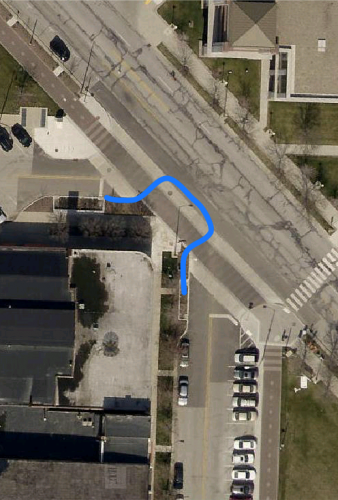
The only real solution is to tear out the concrete and pavers and redo it with the above recommended fixes. I don’t see this happening soon.
Virginia Ave rail viaduct and Banker’s Life parking garage
Severity: high
Fixability very low
This is easily the most depressing portion of the Cultural Trail. You can’t plant trees down there and there is no sunlight. It is typically about 10 degrees cooler here and feels slightly damp all the time. While that might be ideal as a respite in the hot summer weather, for 95% of the year, it is very uninviting.
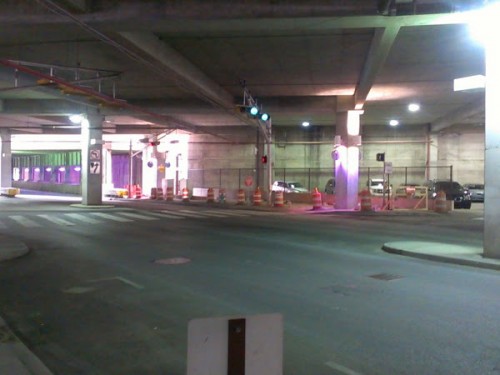
While there has been an attempt to make this space something unique with the Acconci light sculpture, so far it has been a bust. Fortunately, there may be an end in sight as Nuvo is reporting that it should be finished by September assuming that electronic testing goes well in June.
The obvious fix is to remove the rail viaduct and garage. Of the two, I see the Fieldhouse garage as being the more sticky of the two. CSX already has a bypass around downtown although they probably won’t be leaving anytime soon. The Fieldhouse garage is fairly new and I don’t see it going away until many more surface lots in the area have been developed. And honestly, I would be shocked if that happens in the next 50 years.
Legion Mall
Severity: low
Fixability: high
The Cultural Trail essentially ends at Pennsylvania and North St on the east side of Legion Mall and picks back up at Meridian and Walnut St on the west side. According to Chris Barnett on Skyscraper City, the Mall is considered a historical district and no accommodations could be made for the Cultural Trail.
It seems very unfortunate that the connectivity is lost in the section which is adjacent to the recently revamped Central Library, a Scottish Rite Cathedral in the midst of being refurbished, and some of the most impressive war monuments outside of Washington, DC.
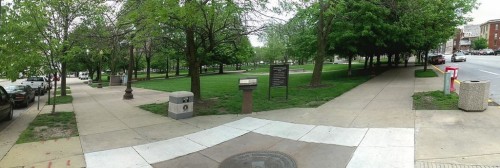
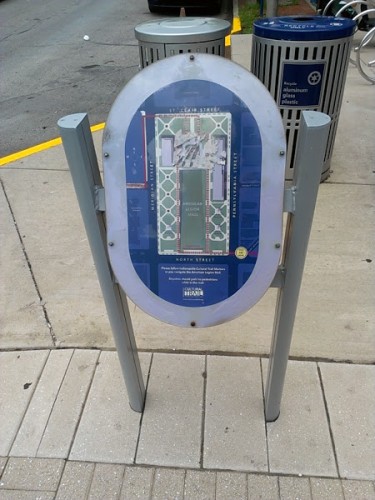
The fix for this would be to head north on Pennsylvania, cross in front of the Central Library, and connect up where the trail ends at Meridian and St Clair St.
Walk buttons
Severity: medium
Fixability: high
Over on the Gateway Arch post on Urban Indy, there was a good discussion in the comments about walk signal buttons. This included inaccessible ones (at Raymond and Meridian, where the button is off the sidewalk and over a curb), placebo ones not connected to the light cycle, and required-press buttons. While the Cultural Trail does not have any of the first, it abounds with the latter two. Here is a video of the light cycle at Michigan and Blackford St.
http://www.youtube.com/watch?v=Z9_Qg4YiCtE
This is just a poor decision given that the IUPUI campus is one of the most walked areas. Students are walking this area very regularly and shouldn’t be required to press the button. I had to wait through 2 cycles to take that video because people DID want to cross and kept pressing the button.
While it is annoying to have to press the button and wait as a walker, it is even worse as a jogger. You might arrive at a light, press the button while the green is your direction, but then the walk signal doesn’t show up till the next green. The joggers I saw disregarded the walk/don’t walk signal altogether, which is unfortunate because it puts them in unnecessary danger.
As for the placebo buttons, these aren’t as bad, but still give you a false sense of being in control of the light cycle. If the button doesn’t ACTUALLY control the cycle, why put it in?
The fix is to get rid of all buttons on the trail and have a pedestrian walk signal with every light cycle. This is super easy to fix.
Light timing
Severity: low
Fixability: Extremely high
It also came up in the Gateway Arch post that there are some light cycles on the Cultural Trail that just don’t make sense. The first is the light crossing Ohio along Alabama. There is about 30 seconds of dead time between the end of the pedestrian crossing and the left turn arrow. This is compounded when going northbound on the trail since you can’t even see that the left turn has a red light and a safe jaywalk could be attempted.
http://www.youtube.com/watch?v=P2_vJ-wCyZ4
Another example that is solely about cars over any other mode of transportation is the pedestrian crossing light to cross Pennsylvanian westbound to the Legion Mall. There, southbound traffic gets an 80 second light, which is, on its own, ridiculous. Then couple that with a walk signal that doesn’t change until after Fort Wayne traffic gets the signal and you get about 30 seconds out of a nearly 3 minute cycle that is dedicated to pedestrians.
http://www.youtube.com/watch?v=hjXeEWRpNuY
The fix is to retime the lights to consider all modes of transportation but, considering that I informed the Mayor’s Action Center about a month ago about the Ohio light, it could be harder than it seems.
The Conrad valet parking
Severity: high
Fixability: high
We’ve talked about this numerous times here, on Twitter, and elsewhere around the web. The Conrad uses the Cultural Trail in front of the hotel as a parking lot. They claim it is for short-term drop-off and check-in, but it is very obvious that cars stay there for hours. The pictures below were taken on a Wednesday which is a slow day and there were 5 cars parked. None were idling or being unloaded. On a busy day, I’ve counted 16 cars parked on the trail.
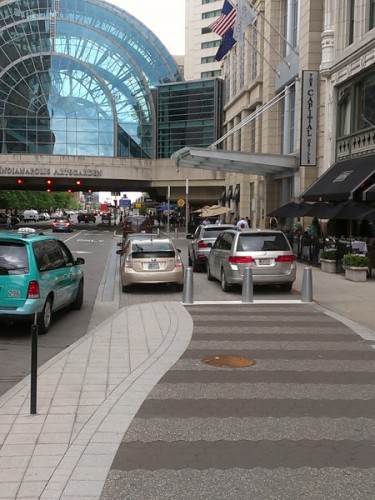
The reason I gave this a high severity is not for any personal danger to pedestrians, but because we have a world-class piece of infrastructure that has been written about around the world. People from Chicago, London, and other far off, cosmopolitan locales are jealous of what we have. Parking cars on it is a slap in the face of everything it represents and makes the whole thing feel cheap. Imagine building a world class health and fitness facility and then putting a McDonald’s in the lobby.
The fix is an easy suggestion: move the valet area elsewhere. However, in practice it could be difficult to fix since there are likely deals and agreements that have existed before the trail was even around as to how the Conrad can use that space.
That about covers it. Be sure to share you comments on what I’ve listed here or if you have your own changes or fixes you would like to see. And finally, thanks to Urban Indy for letting me post!
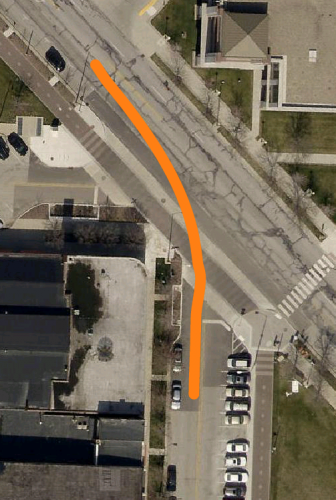
Nice overview. Did you share this directly with any of the folks involved in the Trail? I’d be curious if they see things similary and what if any accommodations they are considering for the future.
I had messaged the Cultural Trail on Twitter a couple of times and filled out a form with the Mayor’s Action Center about a month ago for the light timing stuff. I kind of figured it would be fixed for the grand opening, but it is still busted as of today.
I also sent a copy of this article to the “contact us” link on the CT website. If anyone knows a more direct contact, I would love some direct feedback from CT staff.
You are getting some. Just probably not as high on the ladder as you want to be going.
Curt has my contact info.
Turn radius: if a curb was built, do you honestly think drivers would honor it? No. they would start shooting down that 20′-30′ section of the trail to make the turn making things MORE dangerous. At least there are good sightlines
Parking garage: Not much you can do. Honestly though, spend all that money to tear down a garage for the trail?
Legion Mall: A very good idea
Push buttons: To be honest, my opinion on these are that they are intended to help/assist those that have disabilities. Those of us who are not blind, or have visual impairments, or a walking disability can easily use the grey matter in our skulls to discern when we can cross safely (so long as they are not in mid-text). The buttons are there to help those that need assistance. I don’t see the need to change it.
Light timing: I said it before; the (one!) person responsible for this is GONE. it is going to take some time but these issues are known
Con…yea….: Believe me, this one gets under my skin more than anything else on the trail. There were more headaches with this than any other portion of the trail on Washington St.
RE: Push Buttons – I don’t think pressing the button is a huge help to the disabled. For the visually impaired, audible cues are much more important and those can be included in a dedicated pedestrian cycle. For walking disabilities, longer cycles and shorter crossings would be a bigger help than buttons as well. Buttons just make the planners feel good, I think.
RE: Light timing – I remember you saying that on the Gateway Arch post. That is pretty ridiculous that everybody on the DPW maintenance crew can’t figure out how to time a light. Then again, I worked for the State so I know about “protecting the kingdom.”
Regarding the signal timing, I wouldn’t think that it would take any longer for someone to go out and fix it than it took for whomever went out and screwed up a few months ago. I don’t accept that they don’t have the resources to get it done. I think they don’t see it as a priority.
I’m glad I’m not imagining things with the Ohio and Alabama signal. It hasn’t always been like that. It certainly wasn’t last summer and perhaps not more than a month ago. Still, I am surprised that the dedication came and went without a fix.
As I said above, I’m shocked it wasn’t fixed for the grand opening as well. My theory is that they changed the southbound Alabama light (I recall it being shorter) and never changed the Trail portion of the timing. If you look at the pedestrian signal crossing Ohio, it is much shorter than the light as well.
I believe that the explanation is much more sinister. Okay, sinister might be too strong of a description. But, I really believe that it is part of a systematic policy that sets the pedestrian signals to give only the minimum amount of time deemed necessary to cross the street, something like 1 second per 3.5 feet, regardless of how long the green light phase lasts. Old school traffic engineering manuals indicate that only that amount of time need be given to the pedestrian, and I’ve seen this implemented at many signals throughout Indy.
Look at the ped signals at Washington & I-65/70. They give a minimal time for peds that is much less than the green light provides. I had an e-mail conversation with DPW about that when this intersection was rebuilt. They weren’t very receptive about making changes, although they did add a few seconds to the ped signal to cross the I-65/70 entrance ramp. Unfortunately, it’s still lacking in providing an appropriate amount of time.
I also had a brief conversation with a technician who was working on the signals at Alabama & Maryland. I asked him if they could provide more time to cross Maryland since there is a bunch of wasted green time that gets a solid hand on the pedestrian signal, and he did increase the walk time by about five seconds, so now there is only about ten seconds of dead time. Again, it’s another terrible situation, because as a northbound pedestrian, you know there is more time to safely cross the street, but since Alabama is a one-way, you can’t see the green light so you either have to risk it, or stand at the curb like a dummy when, maybe, you could have safely crossed the street.
The real problem is that I don’t think this is just a mistake. Therefore, there might be a DPW policy that needs to be changed to indicate that the ped signal will be given the full amount of time granted to cars.
The problem with your theory is that the current setup isn’t car-friendly, either. It’s just stupid. After a very short walk signal, the red hand sits there for 30 seconds while the left turn arrow is red as well. So, if people are following the signals then both pedestrians and car drivers are sitting there twiddling their thumbs.
I agree that it is just stupid on the CT intersections where the turning movements are controlled by turn arrows. But, I think that this is their default policy for all signals, perhaps so that other vehicle turning movements might not be obstructing by crossing pedestrians while the solid “Don’t Walk” signal is displayed.
Even at the CT intersection of Alabama & Ohio, the same short walk phase is in effect to cross Alabama as well, where presumably it will keep those inconvenient pedestrians out of the path of turning vehicles from Ohio onto Alabama.
I almost always park at meters on the north side of Ohio when going to City Market or CCB. I almost always jaywalk across Ohio, and then walk down the trail to the marked (but uncontrolled) crossing at Wabash.
I honestly don’t see why the crossing thing is such a big deal at Ohio and Alabama. Except at rush hour and Farmers Market days, it’s never so busy that you can’t intelligently disregard the signal and cross; when you’re crossing south to north, even though you can’t see the traffic signal, YOU CAN SEE THE TRAFFIC because it’s coming straight at you.
Think Hans Monderman: if you can look the driver in the eye, you can negotiate safe passage with him/her.
ps. I picked up the historic district info at a Cultural Trail meeting held by Indianapolis Downtown, Inc. and repeated it on a post somewhere.
Whereas you and I might feel confident to cross against a “don’t walk” signal, most pedestrians and bicyclists that I observe actually adhere to the pedestrian signals, and it’s unfortunate that they are made to wait another 45 seconds for the next “walk” phase when there is plenty of additional “walk” time that could and should be given.
It’s very inconvenient to pedestrians and it seems a little careless to suggest that people should feel obligated to ignore the pedestrian signal. Whereas, we might do it safely 99.9% of the time, people do make errors in judgment and people do get severely injured and even killed that way. There’s just no excuse for the City contributing to an increase in reckless behavior in order to overcome their improper signal programming. This also sends a message that our City is not pedestrian friendly and/or is incompetent, despite the grand investment put into the CT. That’s why I think it’s a big deal.
Great post Andy! I wrote about another design flaw way back in ’09. It’s about a ridiculously narrow piece of sidewalk followed by a complete elimination of sidewalk near the Glick Peace Walk on Walnut:
http://dig-b.blogspot.com/2009/08/photos-indianapolis-cultural-trail_18.html
Another flaw I discovered is a lack of crosswalks and curb cuts at the intersection of St. Clair and Fayette St.:
https://maps.google.com/maps?q=indianapolis&hl=en&ll=39.778379,-86.166339&spn=0.000603,0.000414&hnear=Indianapolis,+Marion,+Indiana&t=h&z=21&layer=c&cbll=39.778379,-86.166339&panoid=p19G_oKYAZcXzvR2N50HWg&cbp=12,171.18,,0,4.81
Two things to note about that: (1) admittedly this wouldn’t be a terribly difficult jaywalk, except that they also have a raingarden and densely packed plantings along the Cultural Trail that make it difficult to impossible to get through, and (2) just to the west, there are crosswalks where California and Camp intersect St. Clair, so the designers had a template for how Fayette/St. Clair should have looked. No idea how this was overlooked.
That’s why you don’t put a cycle track or bike lanes where they’re going to block people from getting to a business.
I would also point out one broad failing in that the Cultural Trail team didn’t push through a two-way conversion of Alabama at the same time as the construction process. Traffic counts even during morning rush hour do not warrant three southbound lanes, and with one lane dedicated to a series of left-turns-only, it’s really only two through-lanes anyway.
I have a feeling that, if the Alabama corridor were constructed today, we probably would have seen a conversion.
I’ve always thought that the shared sections of the Trail are a major flaw. As the Trail becomes more popular, especially for bikers, it just doesn’t seem practical and safe to have groups of bikes and groups of pedestrians squeezed into a 10′ wide sidewalk. It’s downtown, you should already have sidewalks that are at least 10′ wide, without having bicyclists on them.
I know it would have caused them to buy some additional property, or further narrow streets. I think it would’ve been worth the effort and cost. The block adjacent to the Murat’s parking lot is a good, or bad, example, especially given that there is little to no separation from the NB vehicle lane. Would it have been that infeasible to acquire a small strip of the surface parking lot?
The problems you’ve indicated were problems that existed before the Cultural Trail.
But when you’re spending $60 million to upgrade infrastructure, doesn’t it make sense to actually, you know, upgrade infrastructure?
The Mall: Wow that confused the heck out of me the first time I tried to ride the Trail. Disappointing. A few simple signs would make it serviceable.
The Conrad: During “Get Down On It” I noticed that they may have escalated the conflict. Their little “parking lot” is now roped off, preventing pedestrians and cyclists from going through it. Not sure if it’s still in place but if it is, I’m even more vexed.
“Imagine building a world class health and fitness facility and then putting a McDonald’s in the lobby.” You mean like Riley Hospital? BAM! Couldn’t resist. 🙂
All of that said, I’m still giddy that we have this trail!
McDonald’s are in many children’s hospitals as a quid pro quo for Ronald McDonald Houses.
Great post Andy–especially like your observations on the turn radius, which is obviously a common problem in a city with a number of diagonals like Indy has, but it’s particularly problematic when the diagonals aren’t three-way intersections. So this New Jersey-Virginia combo is a perfect example. Thankfully this stretch of New Jersey goes virtually nowhere and thus is rarely used, but it still could prove a huge safety hazard.
Unfortunately, that stretch of New Jersey isn’t rarely used. Virginia/New Jersey is the shortest route from downtown to the Lilly parking lots on South St.
Instead of the cultural trail. The city would have better off and made more money, if it had done away with some on-street parking and made many more “South Shelby St.-like” bike lanes.
Oil and Water = Bike Path and Sidewalk
I would say that over distance something like the Shelby bike track makes sense. The Cultural Trail, while 7.5 miles long, is contained in an approximately 3 square mile area.
I would definitely advocate for protected bike tracks coming downtown along New York or Michigan on both the east and west sides. I would also love to see the Shelby St lanes extended all the way to County Line on the southside, although a greenway is still needed in that direction. Illinois needs one going north.
Nice post!
Is there any word on when or if they will ever complete the construction of the trail in the parking garage on Virginia Ave?
Hi Fiona.
I haven’t heard any word on when it would be completed, but my wife and I just noticed the other day that the lights on the floor and above are on. They are not motion sensing, but just full on for now. Hopefully that means we are getting close!